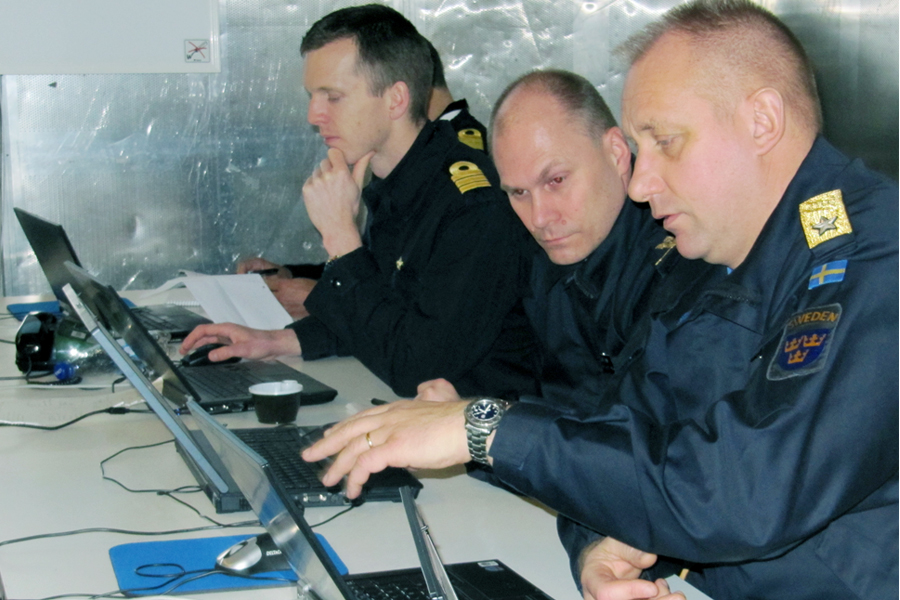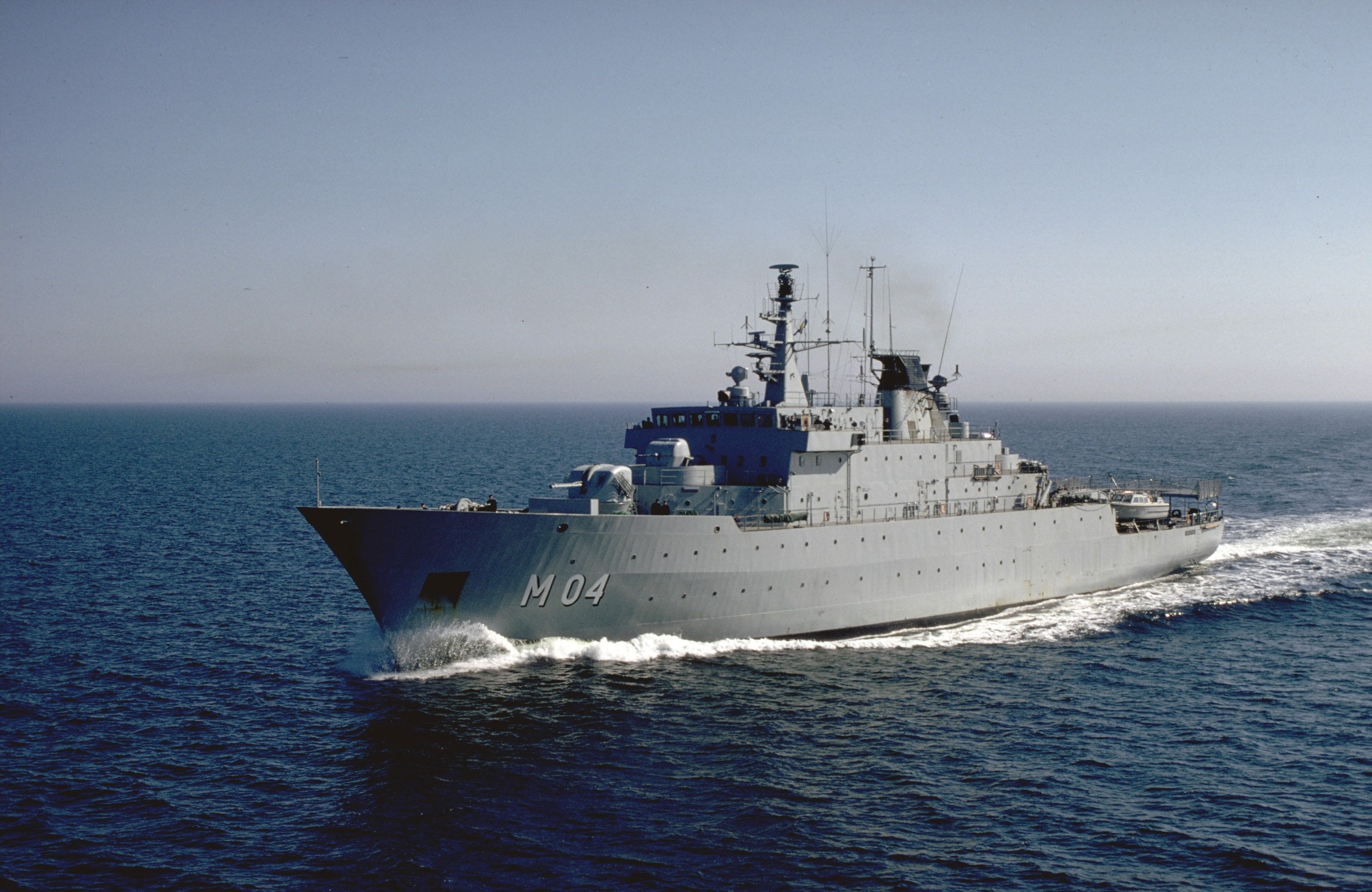Swedish Navy set to lead EU mission.
A Swedish admiral is ready to take command of the European Naval Force in its anti-pirate mission off the coast of Somalia. One year after proving its ability to operate far from home waters, the Swedish Navy takes over command of UNAVFOR from Italy.
-
 Rear Admiral Jan Thörnqvist, right, works on a communications problem with members of his staff during training in England. Photo by Carl Sjöstrand/Forsvarsmakten
Rear Admiral Jan Thörnqvist, right, works on a communications problem with members of his staff during training in England. Photo by Carl Sjöstrand/Forsvarsmakten -
-
By Chipp Reid
-
 The HMS Carlskrona—Sweden's largest warship—is on its way to the coast of Somalia where it will serve as the force headquarters of the EU Naval Force. Photo by Thomas Wingstedt/Försvarets Bildbyrå
The HMS Carlskrona—Sweden's largest warship—is on its way to the coast of Somalia where it will serve as the force headquarters of the EU Naval Force. Photo by Thomas Wingstedt/Försvarets Bildbyrå -
-
One year after proving its ability to operate far from home waters, the Royal Swedish Navy is ready to flaunt its command and control muscles as it takes over from Italy as the force commander of the European Union Naval Force (EUNAVFOR).
Rear Admiral Jan Thörnqvist officially takes command of the multinational maritime force April 14, although he leaves for Alexandria March 26 where he is to join HMS Karlskrona as she transits through the Suez Canal. Karlskrona, the largest ship in the Swedish Navy, will be Thörnqvist’s floating headquarters during his four-month stint in command.
“This is a once in a lifetime chance,” Thörnqvist said to Nordstjernan in an exclusive interview. “You don’t get the opportunity to command an international force every day. In fact, I don’t know when Sweden last sent out an admiral. I have done a lot of things that I have liked in my career but this is the most challenging thing I have been asked to do.”
Thörnqvist is the first Swedish admiral to command an international maritime force and the first Swedish officer to have overall tactical control of an international force. Sweden commanded a brigade during the initial stages of the NATO intervention in Kosovo in the mid-1990s, but that brigade operated under overall NATO command. Thörnqvist will be in charge of the day-to-day operations of EUNAVFOR as well as its forward headquarters. He will report to EU Naval headquarters in Northwood, England.
“I am the commander of the whole EU NAVFOR—the Swedish contribution will continue into August,” Thörnqvist said. “This is something big for a small navy like that of Sweden. We’ve done lots of training. I think we have done as much as we can. Communication has been a big issue until now but we have solved all the problems. I am pretty confident (of success).”
The Royal Swedish Navy opened more than a few eyes last year to its operational potential when it sent two corvettes—the HMS Stockholm and HMS Malmo—to the Gulf of Aden to take part in Operation Atalanta. The two ships captured five pirates, thwarted several attacks and had a 100 percent success rate of escorting vessels carrying food into Mogadishu for the World Food Program.
Thornqvist said he wants to build on that success. He said the key would be his ability to coordinate his forces with those of other task groups operating in the area.
“I know it is a big challenge,” Thörnqvist said. “The most important part to be successful is to work together, to try to coordinate our operations and not to do something exactly the same. We don’t want to send two ships into the same area. It’s a huge area—comparable with USA in size—that we’re going to cover. We’re also trying to help each other even though we all have different mandates.”
The United States, NATO and a group of individual nations that includes Russia, China and India all have naval forces patrolling the seas off Somalia. The NATO- and U.S.-led forces operate under their own mandates.
The Swedish Rear Admiral takes over the EU force from Italian Rear Admiral Giovanni Gumiero. One of the toughest issues he could face is how merchant vessels respond to the pirates. April through August is usually the busiest time for pirate attacks as the weather is optimal for small boats to operate on the Indian Ocean. Thörnqvist said he is against the idea of merchantmen either arming crews or carrying armed security.
“We are looking into that very carefully,” he said. “There is always a risk if you arm yourself it could escalate what the pirates do. They could bring in other kinds of weapons and it could also risk hostile acts against the ships already hijacked. We are well aware that is exactly what is happening and at the moment it is not something the EU NAVFOR is recommending.”
Thörnqvist began his career in the Royal Swedish Navy in 1976—“I was very young,” he said—and spent much of his career in surface warfare. The admiral’s expertise is in mine warfare (he is a certified clearance diver) and he also attended the U.S. Navy War College in Newport, R.I. He said that while his experience more than prepared him for his new command, hunting for mines and searching for pirates are very different tasks.
“That’s why we’re doing a lot of training in the Baltic Sea to get ready," Thörnqvist said. "Plus, people must remember the Swedish Navy really has two roles, one in the Baltic Sea and another as part of international operations.”
The Swedish warships that take part in European Union or United Nations operations are essentially coastal defense craft. Thörnqvist said although designed for use in the shallow waters of the Baltic Sea, the Swedish navy has the capabilities to operate far from home.
“We always stand with one foot in Baltic and one in multinational waters,” he said. “We’re trying to keep up with the rest of Europe and I shouldn’t be surprised if our ships are able to do both in better manner. We have smaller ships now but the size of our ships is getting bigger. We are prepared to do both. We can’t leave the Baltic. We must always have something back home while we also want to be able to send something in multinational operations.”
Although Thörnqvist is to hold command for just four months, the Karlskrona is to remain on station until mid-November. Originally a mine warfare vessel, the Karlskrona went through a lengthy upgrade to turn her into an Ocean Patrol Vessel. She is also the largest ship in the Royal Swedish Navy.
Thörnqvist said he believes his country’s biggest warship could have a big impact not only on the EU operation but in how other countries view Sweden.
“We have good crew members and good equipment,” he said. “Our corvettes Stockholm and Malmö worked only in the Gulf of Aden. Our area of operations is much bigger. They had very good results and I think we have the personnel and equipment to be just as good if not better.”
“I am honored to have this job,” Thörnqvist said. “I will do my very best to keep the waters of Somalia safe. It is a huge area but we will do our best to do our job.” -
-
